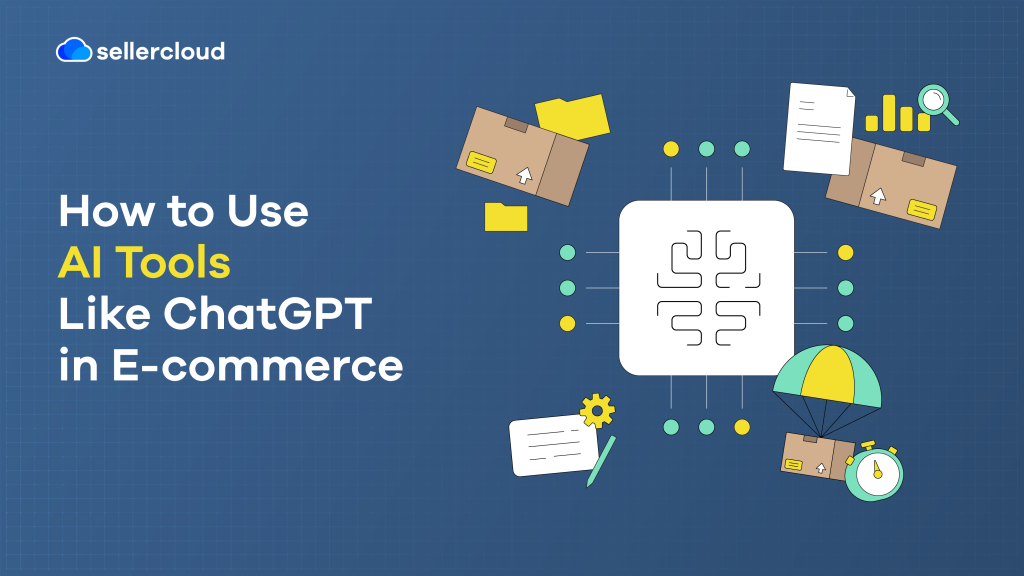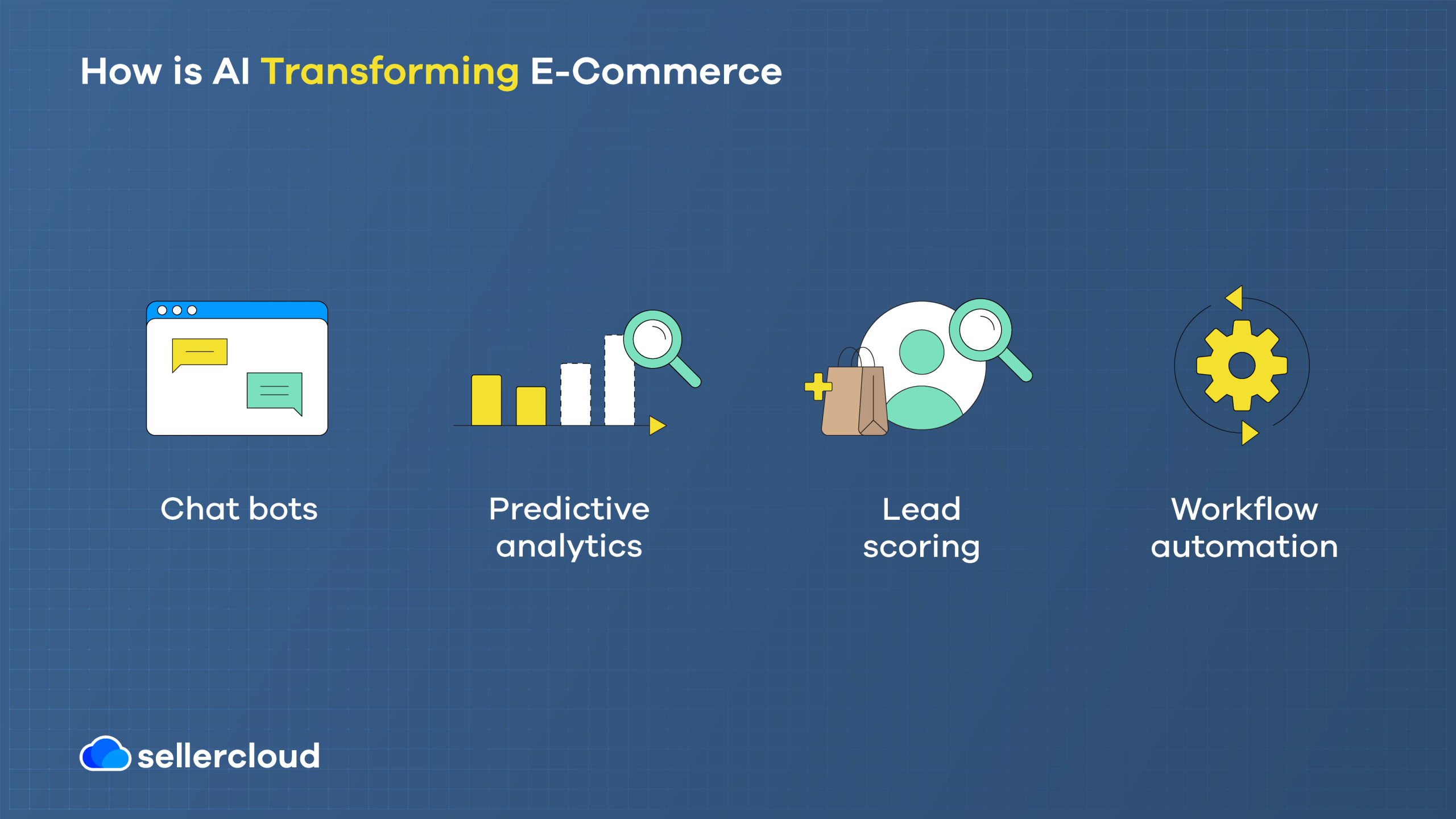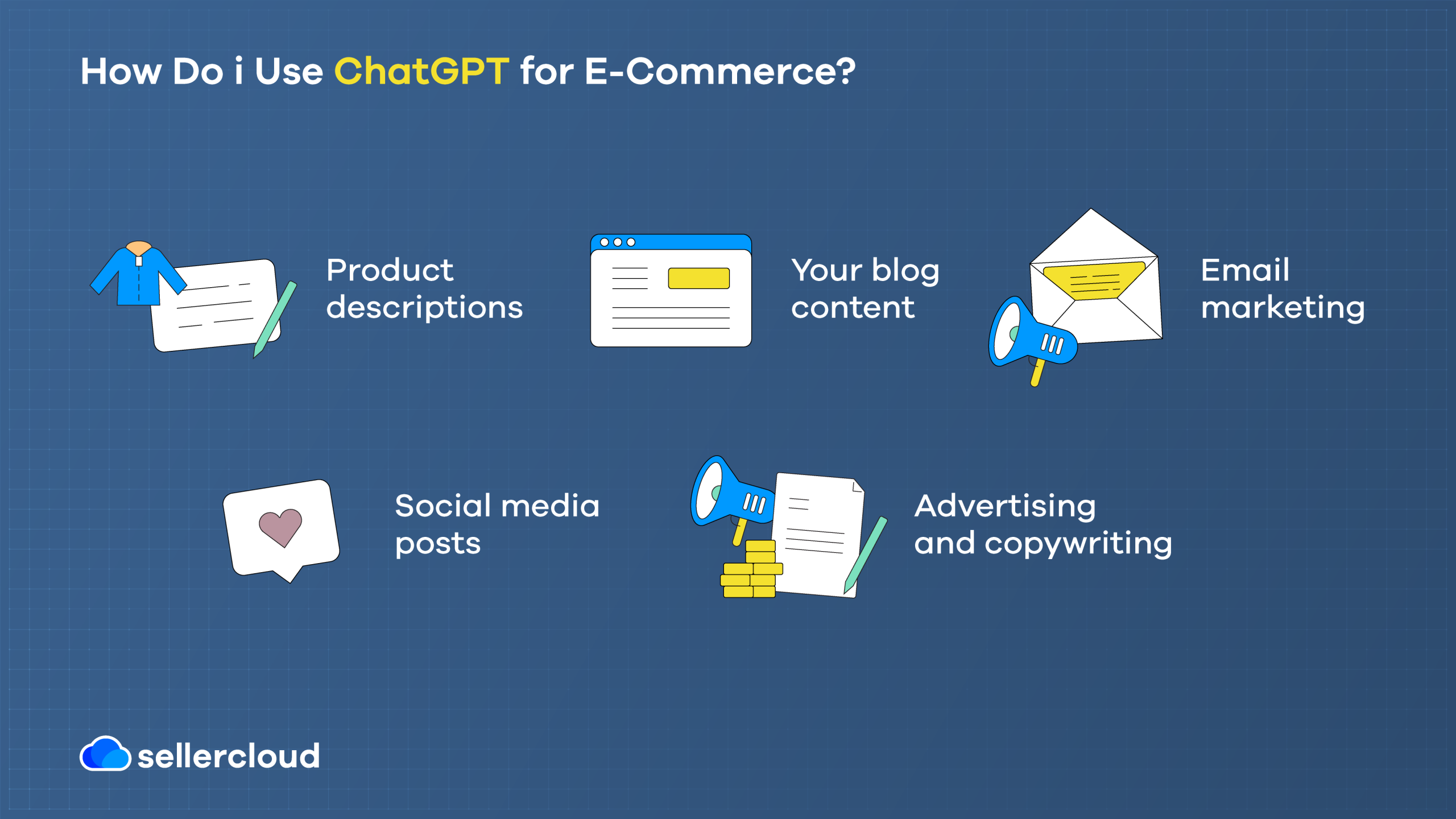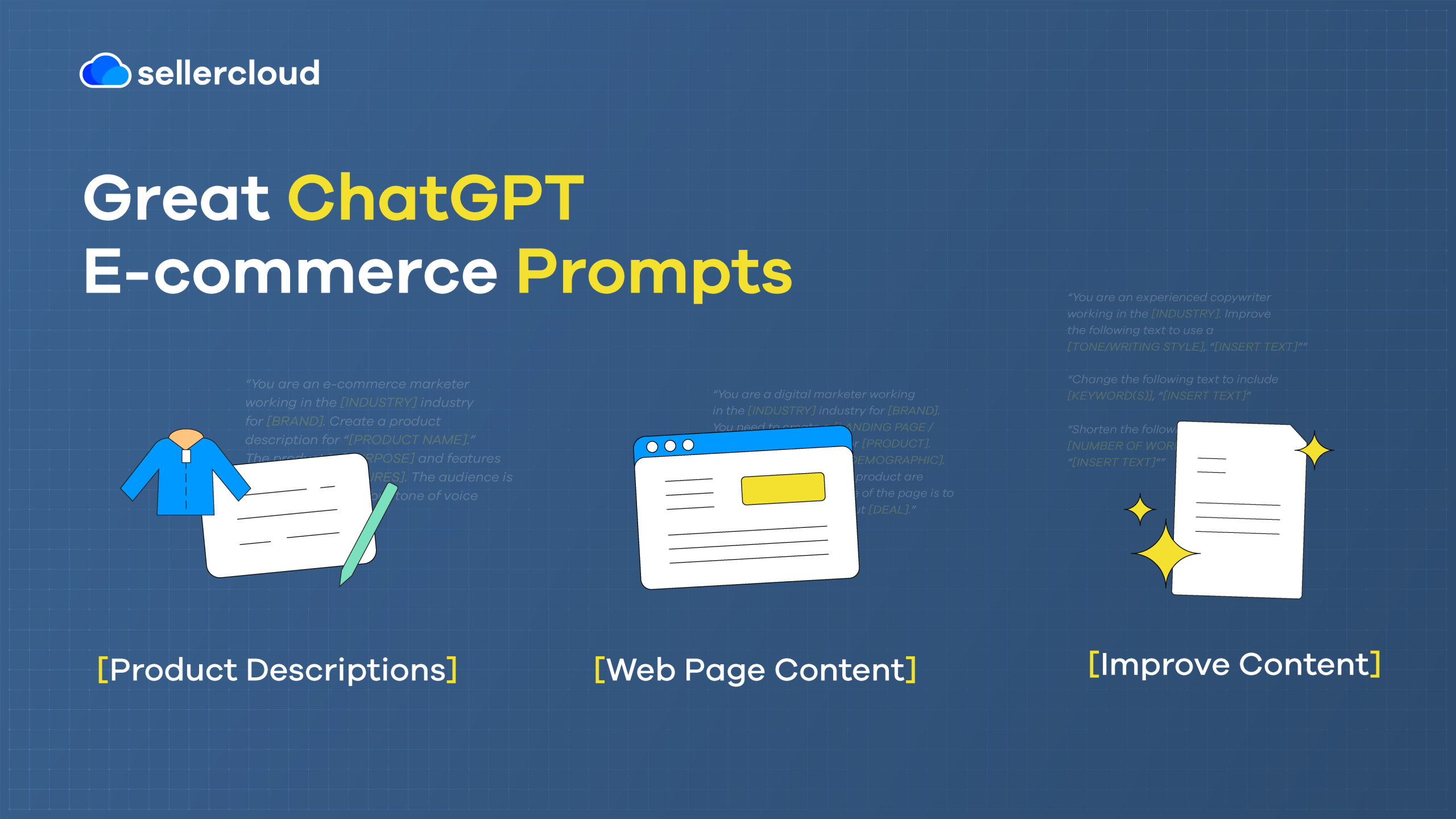
- AI has been a driving force for change in ecommerce for a while now, and it powers a range of tools and features consumers use daily.
- Generative AI tools, like ChatGPT, are helping ecommerce companies with a host of tasks. Learning to ‘prompt’ will get you better results and avoid problems.
Artificial intelligence (AI) in ecommerce is nothing new. AI has been around for a while, helping customers and online merchants with minor tasks. We often take it for granted, like when you type something and it guesses what you want to write next. This is called ‘narrow’ AI; it can perform very basic tasks.
What we have today is ‘generative AI’—it can be used to create new content, is much more complex, and is a phenomenon that ecommerce businesses cannot afford not to catch. ChatGPT (‘GPT’ stands for ‘Generative Pre-trained Transformer’) is the most well-known generative AI tool, which we will discuss at length.
In this article, we’ll cover how AI is changing ecommerce and how to use tools like ChatGPT to automate multiple areas of your ecommerce business.
How Is AI Transforming Ecommerce?
AI has already had a massive impact on ecommerce, starting a race between many companies to integrate AI in the most efficient ways.

Many ecommerce platforms are looking to embrace AI tools. Some well-known platforms include JD.com, Amazon, and Shopify. That’s even before we mention all the ChatGPT copy-cats, like Google’s Bard and Bing’s chatbot, that are angling for different ways to dominate the AI tech sector. Plus, overseas, China’s Baidu, South Korea’s Naver, and Russia’s Yandex are all creating their own AI chatbots that will power a wide range of ecommerce functions.
In an article by Shane Barker on the future of ecommerce and Shopify trends and predictions, AI takes center stage for 2023. Barker notes four ways AI will change ecommerce:
- Chatbots. While many ecommerce stores already have chatbots, AI could mean we’ll see more intelligent support that can solve more complex queries.
- Predictive analytics. Combining AI and predictive analytics, ecommerce stores can gain insights into customer behavior.
- Lead scoring. AI can calculate the likelihood of a potential customer making a purchase.
- Workflow automation. While many use cases exist for automated workflows, Barker highlights how they can be used for product descriptions.
Elsewhere, Cassie Wilson of HubSpot explains the basics of AI and how it is dramatically changing marketing. Wilson writes, “Artificial intelligence is an advanced technology, typically run by a series of algorithms, computers, or robots, that uses real-time data to simulate human intelligence.” In the same article, Wilson lists four benefits of AI: 1) it reduces human error, 2) research and data analysis, 3) makes unbiased and smart decisions, and 4) performs repetitive tasks.
How to Use AI in Ecommerce
As mentioned earlier, the current buzz around AI in ecommerce is nothing new. Narrow AI has been utilized by ecommerce platforms for a while now. Perhaps the oldest instance of AI in ecommerce is Amazon’s recommendation system, which recommends products based on customer activity to create a personalized experience. Today, we’re so used to recommendations that we barely even think about them being AI. It’s almost an expected part of the online shopping experience.
AI is perfect for these tasks because it’s excellent at identifying patterns. It can even spot suspicious activity that could be a scam. However, AI can do a lot more for ecommerce than spot patterns.
Customers are also highly used to ‘virtual assistants’ or ‘VAs.’ Powered by AI, VAs can operate as chatbots and handle customer queries. On a deeper level, AI can also assist with product pricing, inventory management, and sales forecasting.
2022 was a massive year for AI. Before ChatGPT (which we’ll get to soon), AI image-generating tools burst into the scene, and sites like Midjourney and Stable Diffusion became enormously popular. With these tools, users could write prompts, and the tool creates ‘synthetic media,’ attempting to create what you’ve asked it to, usually relying on media it already has access to.
Ecommerce companies can use AI tools to show their products somewhere else, on someone else, or even use them in a certain way. But AI’s applications in ecommerce don’t stop there—if anything, it’s just the bare bones of what AI can do.
Another trend is AI-generated personalized videos for thank-you messages. Made in bulk, they make minor changes to the name and how your face moves. BHuman is an example. This is even before we’ve mentioned the plethora of customer chatbots to help customers on many ecommerce sites.
However, you’ll need several AI tools to achieve most of this. As of yet, there is no AI tool to capture it all.
Disadvantages of AI in Online Shopping
Don’t assume that adopting AI is without its downsides. Relying too much on AI can be risky. Nikita Duggal of Simplilearn highlights several potential disadvantages. Firstly, investing in AI can be very expensive, depending on what kind of tools you want to use and to what level you can integrate them.
Another downside is that employees can get used to not having to think about tasks and might not review things as closely as when doing them themselves. Further to that, chatbots are not the best decision-makers when it comes to dealing with complex customer issues.
These disadvantages shouldn’t scare you off from AI, in any case. The benefits are still astounding; we must be aware and plan for the downsides.
How Do I Use ChatGPT for Ecommerce?
Let’s not pretend the reason you’re here is not related to ChatGPT, the most popular AI tool. It is a game-changer for marketing your brand and products and increasing efficiency.

It will free up your time to work on other important things, and failing to keep up with this trend could mean falling behind your competitors.
ChatGPT is most helpful when it comes to tasks that involve writing. In the ecommerce industry, these can include the following:
- Product descriptions. Describe the product to ChatGPT, and it will help you find creative ways to make it appealing to customers.
- Your blog content. ChatGPT can help you write posts, research topics, or create an effective blog outline.
- Email marketing. ChatGPT will make writing easier and help you better target your audience.
- Social media posts. Generate plenty of social media post ideas to keep your audience engaged faster than before.
- Advertising and copywriting. Like blogs, emails, product descriptions, and social media posts, ChatGPT can help you craft compelling ad copy.
Beyond these basic tasks, ChatGPT can also be used to ask strategic questions and help you make business decisions. On a technical level, ChatGPT can also help with SEO practices, such as analyzing a site’s performance and finding ways to improve. Effectively, ChatGPT can automate anything that requires typing and handling data.
Another enormous area ChatGPT will impact in ecommerce is tech jobs. Developers can use ChatGPT to generate code for specific tasks or use it to figure out why something isn’t working. So, if AI tech like ChatGPT doesn’t replace such positions, the developers you work with should be learning how to use it.
There are plugins for ChatGPT that can make it even more helpful. Some are listed on the OpenAI website.
Best Practices for ChatGPT in Ecommerce
ChatGPT is a groundbreaking tool, but it’s easy to make mistakes when you don’t use it wisely. The most crucial thing ecommerce businesses need to understand is that AI tools like ChatGPT can’t generate new content, and they can make mistakes.
When you ask ChatGPT to create content, it uses its access to the internet to search for patterns. It’s also worth noting that its historical knowledge is limited to September 2021.
Companies may even want to avoid using ChatGPT for legal reasons. The content it produces is not entirely original, so you might be recycling content from other companies. Most recently, Italy banned ChatGPT because of concerns about data collection and privacy and its potential to spread disinformation. Reuters reported that, following Italy’s lead, other EU countries may impose a similar ban on Germany, Ireland, and France over data concerns.
Meanwhile, in South Korea, Samsung engineers accidentally leaked confidential data to ChatGPT while using it to solve work problems, unaware that ChatGPT stores this information. So, the lesson is not to input any vital information you don’t want to share with others who may make similar requests to ChatGPT.
In other news, thousands of influential tech figures signed an open letter urging a pause in developing AI tools so that the risks can be properly studied.
Another more tangible problem that ecommerce businesses need to understand about AI tools like ChatGPT is that they have a ‘watermark,’ meaning they have patterns in how they write. This watermark can make it easy for ChatGPT-written content to be detected by machines, specifically search engines. This means it could be penalized and lose rankings, which is the last thing you want for your products or marketing content.
There are ways to get around this, however, such as ZeroGPT. Do note that sometimes, these tools flag content written by people as AI content, so it’s not an exact science. Another way around this is to use ChatGPT to write the content you need and a second AI writing tool to rephrase it, but this may be time-consuming and does not guarantee success.
Rebekah Carter of Ecommerce Platforms highlights several potential alternatives to ChatGPT for written content, including Rytr, Jasper.ai, and Headlime. Elsewhere, some developers claim to have created algorithms that can make AI-generated content less detectable by search engines and more unique.
To get the best of both worlds, you should impose rules where AI starts and ends. For example, you may want to use AI for creating outlines but a real writer for the meat of your content. You’ll also want to take everything ChatGPT generates with a pinch of salt—it still makes mistakes, and you may find yourself falling for its confidence.
Ideally, never use AI chatbots for factual information. You’ll need to double-check them afterward and spend a frustrating amount of time fixing mistakes. Other AI chatbots also make mistakes. Avram Piltch of Tom’s Hardware wrote about how Google’s Bard plagiarized one of their articles and misused the information.
Another issue you can encounter when using ChatGPT is that it can write ‘fluffy’ content, which is written to be longer than it needs to be, perhaps overexplaining things. You’ll either find yourself cutting it down or cutting it out. Editing this kind of content can be a good reason not to fire your writers and instead train them to use ChatGPT.
4 Great ChatGPT Ecommerce Prompts
The trick to getting AI tools like ChatGPT to work for you is to get good at ‘prompting,’ where you write instructions for ChatGPT. Always take the time to think about what you need ChatGPT to help you with before you enter a prompt. The more instructions you provide and the clearer you explain yourself, the better results you will get.
Don’t hesitate to add further instructions if ChatGPT didn’t get it right the first time. ChatGPT remembers previous instructions and adds to them. For example, when generating a product description, you can avoid fluffy content by being more explicit in your prompts and informing the bot of the reader’s knowledge level.
Another great advice is to ask for multiple responses so you can take different parts of those responses to make something unique. For example, why ask ChatGPT for one meta description when it can generate five simultaneously, each slightly different?
It’s also worth noting that a whole industry of companies has sprung up since the launch of ChatGPT to help ecommerce companies make effective prompts. Some of them ask you to input what you need it to do for you, and using that generates a prompt that you can then input into ChatGPT.
Below are a few ideas for prompts you can start with and craft into what you want to do with them.
1. Product Descriptions
It can be hard to create product descriptions, especially if you have many similar products. So, how do you make them all stand out?
You are an ecommerce marketer working in the [INDUSTRY] industry for [BRAND]. Create a product description for “[PRODUCT NAME].” The product is [PURPOSE] and features [IMPORTANT FEATURES]. The audience is [DEMOGRAPHIC]. Your tone of voice is [TONE OF VOICE].
Some additional sentences you can include in your prompt:
- “Write [NUMBER] variations, each no longer than [NUMBER OF WORDS/CHARACTERS].”—Different variations for similar products.
- “Do not explain what you are doing.”—This will stop ChatGPT from explaining what it is doing and only respond with what you have asked.
- “Use the [WRITING FRAMEWORK].”—Inform ChatGPT to use a specific writing methodology.
You can even prompt ChatGPT to write something in the voice of someone famous if you need to achieve a specific tone of voice.
2. Web Page Content
Again, using ChatGPT to create web page content could be more than one prompt. You may use the first prompt to brief ChatGPT on the company and products if they are very complex and you want or need to mention specific things.
You are a digital marketer working in the [INDUSTRY] industry for [BRAND]. You must create a [LANDING PAGE/ PRODUCT PAGE/ETC.] for [PRODUCT]. The target audience is [DEMOGRAPHIC]. The main features of the product are [FEATURES]. The page’s purpose is to inform the audience about [DEAL].
End the first prompt with “Do you understand?” to ensure that ChatGPT understands the topic before proceeding with the next prompt. ChatGPT should confirm that it understands what you have instructed it to do and summarize the instructions.
Using the information above, create an [OUTLINE/INSTRUCTIONS] for a [LANDING PAGE/ PRODUCT PAGE/ETC.]. It must include headings [HEADINGS] and keywords [KEYWORDS].
ChatGPT will then create an outline with bullet points for what could be included in each section. If necessary, prompt ChatGPT to be more specific in certain areas. If you have added more to your first prompt, you can also prompt it to summarize your instructions.
If you need changes, you can ask ChatGPT to forget a specific part of your instructions and then summarize what you have asked to ensure it has removed the unnecessary instruction. When you think ChatGPT is ready, ask it to write up the content.
Another useful thing to mention is that ChatGPT can only output a certain number of characters at once. When it reaches that level, it will stop. If this happens, type “Continue,” and it will finish.
You can use a similar set of prompts to create blog posts, emails, social media posts, and any other written content on your website, such as homepage headlines or about us pages.
3. Improve Content
Do you have content that should be better? Use ChatGPT to rephrase the content entirely. As always, the more specific you are, the better the response will be.
You are an experienced copywriter working in the [INDUSTRY]. Improve the following text to use a [TONE/WRITING STYLE], “[INSERT TEXT]”
You may want to include things like keywords or to find a way to shorten the text, in which case you’d want to change the last sentence to something like:
- “Change the following text to include [KEYWORD(S)], “[INSERT TEXT]””
- “Shorten the following text to [NUMBER OF WORDS/CHARACTERS], “[INSERT TEXT]””
You can then follow up with further prompts to tweak it to achieve a certain style.
4. SEO Research
Neil Patel highlights many ways to use ChatGPT for SEO. The first prompt you might enter is to ask for keywords related to a product, brand, or topic.
List keywords related to [PRODUCT].
From the list, pick keywords you haven’t covered on your site and ask ChatGPT for additional keywords related to that topic.
What are some common [TOPICS/QUESTIONS] questions people have around [TOPIC/KEYWORD]?
Once you are satisfied with the keywords you have generated, you can ask ChatGPT to start creating content related to that topic.
Key Points
It’s worth noting that while ChatGPT is highly popular now, it might not be around forever. For whatever reason, it could find itself supplanted by another, more superior chatbot. Whatever happens, one thing is certain—we’re not done with AI in ecommerce. So, keep these key points in mind.
- Narrow AI is leveraged in many areas of ecommerce. Today, more complex generative AI tools like ChatGPT are making an impact.
- AI benefits ecommerce by creating a more personalized shopping experience, reactive product pricing, and automating tasks.
- ChatGPT particularly impacts marketing tasks, as it can help with ideation and writing blog posts, emails, and social media posts.
- ChatGPT makes mistakes and can plagiarize content, so always fact-check its responses.
- The more specific you are in your prompts, the better responses you will get from ChatGPT.
Book a Descartes Sellercloud demo today.





